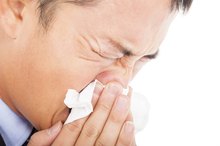Allergies to Bedding
Because most people spend up to a third of their lives sleeping, it is important to focus on the bedroom when it comes to allergy control 2. Many people find that they have various miserable allergic symptoms to their bedding, including sneezing, stuffy or runny nose, itchy eyes, watery eyes and fatigue. Although there are numerous aspects of bedding that can lead to allergies, there are also many ways to work around this and have allergy-free, restful nights.
Bedding Material
Polyester and other synthetic materials contained in bedding can trigger allergic reactions in many people. Even though down comforters are filled with more natural material, it is not uncommon for people to be allergic to the down feathers. All-natural fabrics tend to be better than synthetic ones, with cotton being one of the best solutions. Wool and bamboo can also be great, allergy-free options for sheets and blankets. For comforters, all-cotton or down substitutes can provide allergy relief. Note that many comforters contain polyester filling even if they have cotton covers, so for maximum allergy control, try to find comforters without polyester.
- Polyester and other synthetic materials contained in bedding can trigger allergic reactions in many people.
- For comforters, all-cotton or down substitutes can provide allergy relief.
Dyes
Allergies to Memory Foam
Learn More
Sheets, blankets, bedspreads and other bedding materials often contain dyes that trigger allergic reactions in some people. Symptoms can include skin sensitivities and respiratory issues. To alleviate these problems, it is best to use neutral-colored bedding, such as off white or beige, and that does not contain dye. Also, there are some dyes that are more nontoxic and chemical-free than others. Bedding materials that are advertised as being environmentally friendly or organic are often less toxic, in terms of the dyes they use.
- Sheets, blankets, bedspreads and other bedding materials often contain dyes that trigger allergic reactions in some people.
- To alleviate these problems, it is best to use neutral-colored bedding, such as off white or beige, and that does not contain dye.
Dust
Often, it is not the bedding material itself but the allergens that attach themselves and infiltrate bedding materials that are the true culprits in triggering nasty allergic reactions. One of the biggest offenders is dust, and the unpleasant symptoms can include:
- sneezing
- itching nose
- stuffy nose
- fatigue
- watery eyes
The solution to these bedding dust allergies is fairly straightforward and involves washing sheets and all bedding often enough. Washing these items once per week in hot water can yield almost instant allergy symptom relief. It is important to have bedding that is sturdy enough to hold up to frequent washing in hot water. Using allergy-proofing encasings on pillows and mattresses can help to keep the dust away from you.
- Often, it is not the bedding material itself but the allergens that attach themselves and infiltrate bedding materials that are the true culprits in triggering nasty allergic reactions.
- Washing these items once per week in hot water can yield almost instant allergy symptom relief.
Bed Bugs
Moth Allergy
Learn More
No one likes the thought of bed bugs wreaking havoc on nighttime rest, but these critters’ presence and bites can lead to some unpleasant allergy symptoms. A key way to get around a bed bug problem is preventing the issue from happening in the first place. This involves adding allergy-proofing casings to mattresses, pillows and comforters.
Related Articles
References
Resources
Writer Bio
Judy Wilson has writing and editing expertise in health, technology, pets, business and travel. She has contributed to USAToday.com, SFGate.com and numerous other publications. Wilson earned a Bachelor of Arts in journalism and mass communication from the University of North Carolina at Chapel Hill, where she completed Mini Medical School.








